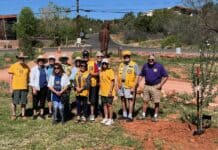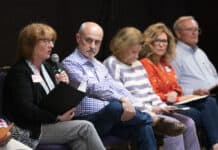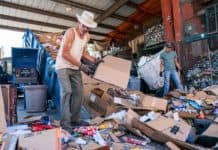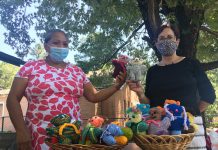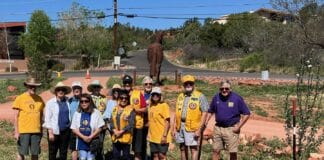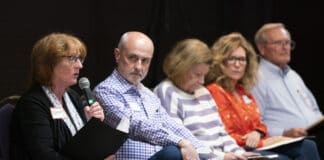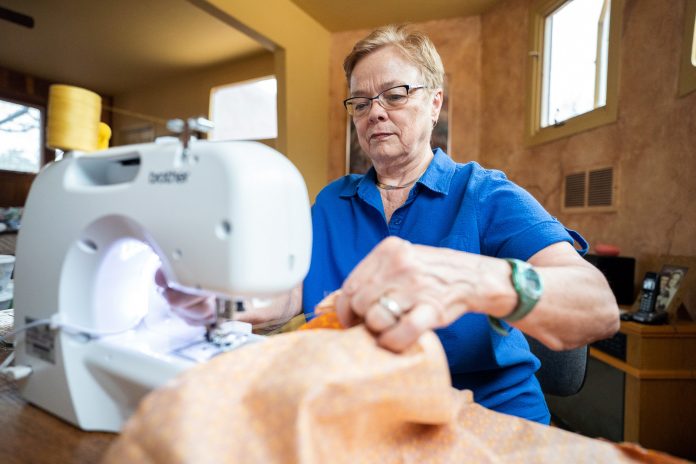
A bedroom in Lin Ennis’ Chapel area home has been transformed into a makeshift studio — a wooden desk is now a sewing machine station with thread, pins and needles about; drawers have been labeled “bias tape,” “elastic” and “cutouts,” and bags of donated fabric find space on the floor.
Brightly-colored sundresses, folded neatly and stacked into piles based on their size, have taken over the bed. In the nearby bathroom, the shower curtain holder is now the hanging rack for a select few dresses on display.
Recently retired, in the last few months Ennis has been, in her words, “making dresses like a banshee.” What first started as a hobby now has a cause — one in which Ennis has poured her heart into.
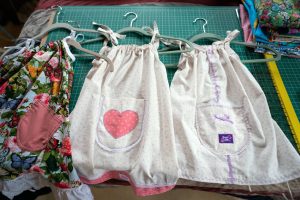
“I realized I would never get my ancient sewing machine serviced out here in the middle of nowhere, so I put it online and sold it and bit the bullet to buy a very, very inexpensive little sewing machine,” Ennis said. “I did some personal sewing for myself — just fixing sleeves and things like that, and I said, ‘well, that was fun.’”
Over breakfast one morning, a friend suggested that Ennis look up a sewing charity.
“I came home from that breakfast and typed in ‘sewing charity’ and Dress A Girl Around the World popped up,” Ennis recalled. “I looked at the pictures of the dresses, the pictures of the little girls all excited, sticking their hands in the pockets and I said, ‘Oh wow, this is cool.’”
Dress A Girl launched in 2009 as part of the nonprofit Hope 4 Women International. It’s goal is to bring every girl around the world dignity by making sure they have at least one new dress.
Specifically, Ennis plans to send the hundreds of dresses sewn by her and the other local volunteers she has brought on board to dress orphaned girls in Malawi, in southeast Africa.
“In the orphanages they may have rags — whatever clothing is donated — any size, any color, any shape, any whatever.” Ennis said. “And what I’ve read about that is that makes [the girls] very susceptible to sex trafficking because it looks like, ‘this girl doesn’t belong to anybody, nobody cares for her,’ and with these labels that we put on the front of every dress, we know — and anybody looking would know — this girl is being cared for by an organization.”
Distinctive white “Dress A Girl” labels are sewn on the front of every handmade sundress.
The organization “could be a school, it could be an orphanage, could be a church — any kind of a group. It just signals, this girl is cared for and she would be missed if she went missing,” Ennis added.
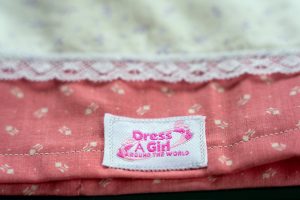
Besides helping to deter girls from sex trafficking in Africa, the dresses also allow the girls to attend school, which they wouldn’t have been able to do in rags.
“And since she has a start in life with education, she may be able to grow up and encourage other girls to be educated and go to school,” Ennis added. “One of the horrendous negative fallouts of poverty is how it separates a person from education, even here in the United States …. So poverty, you can’t really get out of it without being educated.”
“Poverty begets poverty,” added Heather Molans, one of the volunteer sewers who also happens to be Ennis’ neighbor. Molans was also hooked on helping after perusing the Dress A Girl website.
“There’s one picture on there that just broke my heart,” she said. “It’s a little, tiny girl. It looks like she’s wearing a man’s T-shirt — the neck is hanging down to her hip — I saw that and I thought, ‘I’m in.’”
Molans said she used to sew and make all her clothes when she was a kid, but stopped when the fabric and patterns got more expensive than buying pre-made clothes.
She and the other volunteers follow the Dress A Girl chart measurements and simple instructions to sew the dresses. All the materials are already enclosed in the kits they use.
“A kit includes the fabric already pre-cut for a dress, the bias tape for the straps, the elastic for the neckline and a little armhole cutout. So a pattern,” Ennis said.
But while the group has made hundreds of dresses so far, none of them have come out the same.
“I have made every mistake in the book,” Ennis said. “Cute comes out of mistakes. And this is what I told all the ladies at the volunteer meeting. The mistake — by the time you fix it — turns into something really cute.
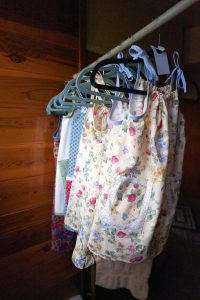
“For example, one of my early dresses was lying on the ironing board while I was cutting some pockets and I snipped a hole in the back of the dress — and [thought] ‘now what?’ What I did with that, I zigzagged across the cut and then I used the pocket material and made a little false belt and put two buttons on it to match the front of the dress — it was adorable. If I hadn’t made that mistake, I wouldn’t have even thought of that design.”
And not all who want to help need to sew.
“One of the ladies didn’t sew,” Ennis said of the first volunteer meeting they had at Church of the Nazarene in the Village of Oak Creek in early March. “That was fine, there was plenty of stuff to do. Going through making sure there were no loose threads, measuring the dresses so they get put in the right stack and go to the right shipment…”
Others donate fabric to the cause.
“The fabric is donated and here in Sedona and the Verde Valley it’s wonderful because this has been such a quilting mecca and a lot of the quilters are sort of aging out of quilting … and they have stashes. Piles of beautiful, beautiful fabrics,” Ennis said.
Money, too, can be donated for the volunteers to purchase supplies for the dresses.
“My retired minister friend said, ‘Lin, I love this project you’re doing, making these dresses.’ And I said, ‘Well, you know these little African girls didn’t know they were naked until you guys [missionaries] went over there and told them that.’ And he sent me $100 for the project,” Ennis recalled with a laugh. “Westerners came over and taught them shame. Now [their] shame has been exploited, so now we’re trying to reverse that by giving them dignity — showing them something they can be proud of.”
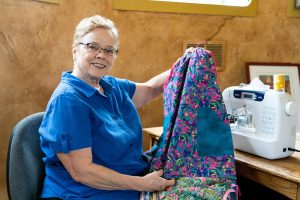
Along with dresses, when the coronavirus pandemic hit, Dress a Girl Around the World Sedona joined Red Rock Quilters, Liberal Ladies and Verde Sews and other sewers in Sedona Kind’s mission to provide cloth masks and gowns to health care workers and community groups that were in need of Personal Protective Equipment.
“The project has been so far cost free due to generous donations of fabric, supplies and sewing machines and transportation from the community who want to support the project in some way,” Sedona Kind wrote on its website. “Over 2,050 gowns have been sewn, and masks number over 5,000 and counting.”
To join Dress a Girl Around the World’s Sedona chapter, visit facebook. com/DAGsedona or call 224-8255.


